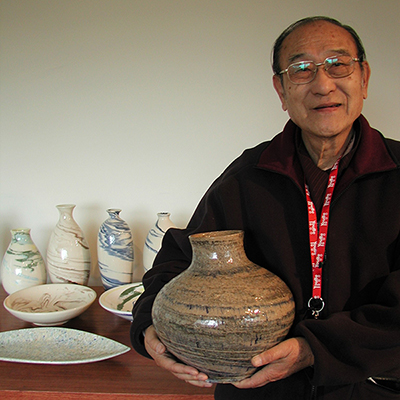
Wu Jang-nung
Wu Jang-nung (1923-2009), originally from China’s Hebei Province, was born in 1923 (1924 according to some sources) in Nanjing. He graduated from the Ceramics Department of the Beiping Art School in Beijing, where his work was greatly influenced by Xu Beihong, who was president of the art school at the time. Xu encouraged Wu to move away from the Jingdezhen framework of focusing entirely on imitating traditional Chinese ceramics and to instead find his own path, and this was one of the reasons that Wu has continuously strived to experiment with glaze and ceramic production techniques.
Wu came to Taiwan to find work in the ceramic arts but would be employed by the Taonai ceramics factory in Beitou, working as a technician producing practical ceramics for daily use, and then went to study ceramics in Seto, Japan. Wu had received a formal education in ceramics, and with the increased interest in arts education in Taiwan, he was able to develop relationships with arts museums in the country and would become a pioneer in researching, teaching and promoting ceramics in Taiwan.
The 1960s and 1970s saw him opening his first personal ceramics studio and opening ceramics courses in major universities and vocational colleges in the country. Wu also pro-actively participated in international ceramics exhibitions, and had on several occasions works selected for inclusion in the Faenza International Ceramics Exhibition in Italy.
Wu Jang-nung’s relationship with the National Museum of History went back a long way. The museum held the Wu Jang-nung Ceramics Exhibition in 1967, the first solo exhibition for a ceramics artist ever held in a museum in Taiwan, followed by a second in 1972.
The internationally renowned Taiwan Ceramics Biennale, currently hosted by the New Taipei City Yingge Ceramics Museum, was originally held, under the name The Chinese Ceramics Biennial Exhibition, by the NMH, which invited Wu on several occasions to serve as a judge during the biennials. As a result, Wu not only contributed to modern Taiwanese ceramics as a researcher, educator and pioneer, he was also a driving force behind the direction in which the field developed.
His most classic glazes can be divided into several series, these being the running glazes and mottled glazes, as well as the tianyuhua blended clay series that he developed after his retirement. He first became interested in the running glazes when he studied the Tang Dynasty sancai “three-colors” glazes as a student, while the mottled glazes are the product of his experimentation with different glazes and how they react on different clay body surfaces to create shrinking of the glaze surface or crackling phenomena, and then creating various visual effects depending on the type of glaze used. Wu developed his tianyuhua blended clay series after his retirement, from innovations inspired by the agateware technique of Chinese ceramics.
The National Museum of History has 30 Wu Jang-nung works in its collection, of which we have selected 10 pieces, according to their glazes.

